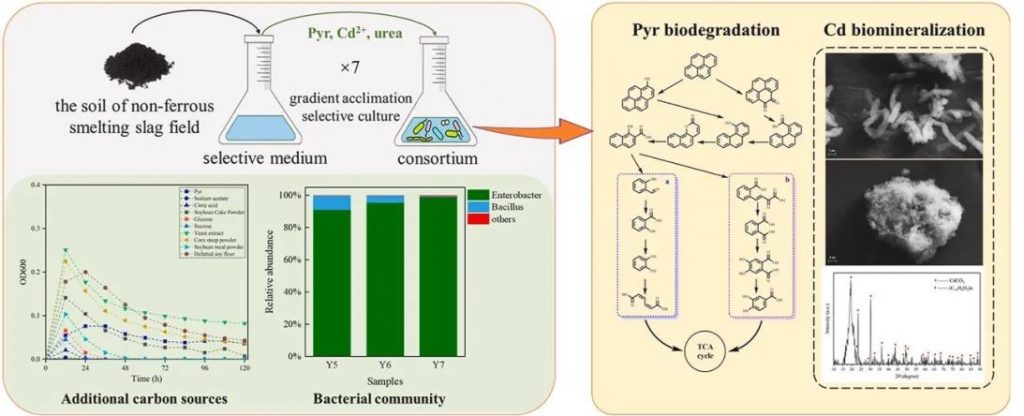First author: Linhai
Corresponding authorProf. Yingbo Dong
Communication UnitSchool of Energy and Environmental Engineering, University of Science and Technology Beijing
DOI: 10.1016/j.chemosphere.2022.135319
✦Image Summary✦

✦Results Profile✦
Recently, Jing-Yun Shi, a master's student in the group, published a paper entitled "Construction of bifunctional bacterial community for co-contamination remediation: Pyrene biodegradation and cadmium biomineralization". In this study, soils contaminated with a combination of pyrene (Pyr) and cadmium (Cd) were used as the research background. A bifunctional bacterial community named Ycp was screened from the soil of a non-ferrous metal smelting slag site, and a microbially induced carbonate precipitation was used to remove Cd2+Biomineralization to CdCO3. This study provides the basis for microbial remediation of complex contamination.
Polycyclic aromatic hydrocarbons (PAHs) and heavy metals are typical pollutants of the non-ferrous metal smelting industry. The combination of biodegradation and biomineralization has great potential as an environmentally friendly method for the removal of co-pollutants. In this study, soils with combined pyrene (Pyr) and cadmium (Cd) contamination were used as the research background. A bifunctional bacterial community named Ycp was screened from the soil of a non-ferrous metal smelting slag site. high-throughput sequencing analysis of the 16S rRNA gene showed thatEnterobacterYcp was the dominant genus (99.1%). ycp was found to be the most abundant bacterium in a wide range of environmental conditions (pH 3-9, salt concentration 0-10 g-L).-1 NaCl, Pyr concentration 0-50 mg-L-1Cd concentration 0-100 mg-L-1) were adaptive, with removal rates of 41.8%-76.9% and 82.8%-98.8% for Pyr and Cd, respectively.It was found that the composite carbon source promoted the removal of Pyr and Cd with maximum removal rates of 88.3% and 98.0%.Based on the degradation products of Pyr analyzed by LC-MS and XRD and SEM-EDS analyses of Cd2+mineralization products, the mechanism of co-pollution remediation by Ycp is that Ycp biodegrades Pyr through the metabolic pathways of salicylic acid and phthalic acid, and through microbially induced carbonate precipitation of Cd2+Biomineralization to CdCO3. This research provides the basis for microbial remediation of complex contaminated soils.
✦Summary✦
In this study, a gradient adaptation and selective culture was constructed toEnterobacterThrough product identification, this study found that Ycp can degrade Pyr through two metabolic pathways, salicylic acid and phthalic acid, and can also induce Cd2+The formation of CdCO3precipitation. Overall, Ycp not only combined the biodegradation of Pyr and biomineralization of Cd, but also maximized the removal of 88.3% of Pyr and 98.0% of Cd. The results of this study provide a scientific basis for microbial remediation of complex contaminated soils.
This study was supported by the National Key R&D Program of China (2019YFC1805002), the Open Fund of the State Key Laboratory of Mineral Processing (BGRIMM-KJSKL-2022-07), and the Fundamental Research Funds for Central Universities (FRF-MP-20-35).
✦Author✦

Jing Yun Shih is a master's student in Environmental Engineering at University of Science and Technology Beijing, with research interests in soil remediation. She participated in projects such as characterization of new organic pollutants in typical groundwater in Beijing.
Finally, we would like to congratulate Ms. Jing-Yun Shi once again and wish the graduate students in the subject group to keep innovating and make further efforts to achieve fruitful results.
Article source: Environmental Biotechnology and Environmental Materials Development Team Public

